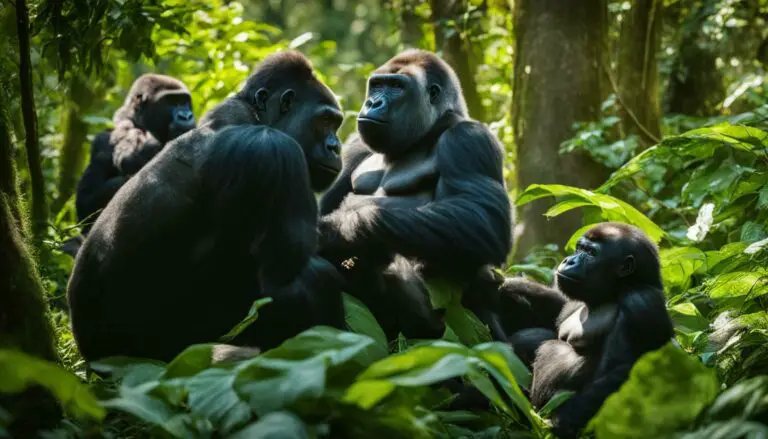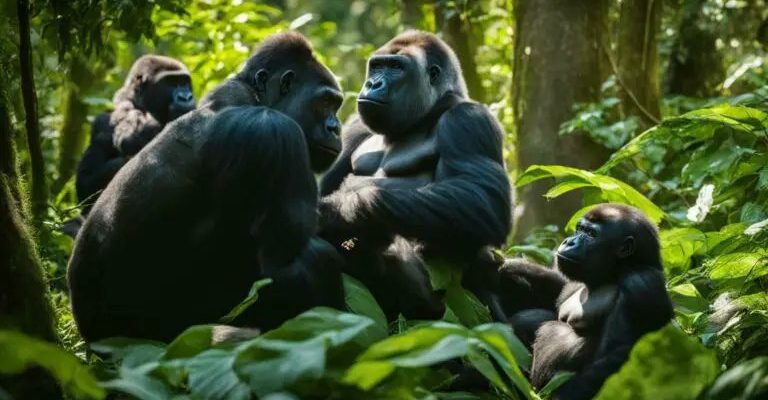
The Range of Eastern Gorillas
Eastern gorillas are mainly found in the mountainous and lowland forests of the Central African region. Their distribution is broken down into two subspecies: the eastern lowland gorilla, also known as the Grauer’s gorilla, and the mountain gorilla. Each of these subspecies enjoys a distinct habitat suited to their needs.
– Eastern Lowland Gorillas: These gorillas inhabit the dense forests of the eastern Democratic Republic of the Congo (DRC). Their territory spans from Kahuzi-Biéga National Park to the Maiko National Park. The lush vegetation and rich biodiversity provide a variety of food sources, including fruits and leaves, essential for their diet.
– Mountain Gorillas: As the name suggests, mountain gorillas live in the higher altitudes of the Virunga Mountains, crossing over into Rwanda and Uganda. Their habitat is characterized by cooler temperatures and thick vegetation, which allows them to hide from predators and thrive.
Both subspecies are critically endangered, so understanding their range helps in conservation efforts. You might be wondering how these habitats are protected, and that’s where the story gets even more compelling.
Understanding Their Habitat
The habitat of eastern gorillas is incredibly varied, and it plays a significant role in their daily lives. This habitat isn’t just a place to sleep or eat—it’s their entire world. Their homes are made up of tropical rainforests, which are essential for foraging food and finding shelter from the elements.
In the lowland jungles, eastern lowland gorillas spend their days moving through thick bushes, munching on diverse plant life, which includes fruits, roots, and tree bark. The forest floor is often covered in a thick layer of leaves and fallen branches, creating a soft place for them to rest. It’s a bit like having a cozy living room filled with snacks!
Mountain gorillas, on the other hand, navigate rocky terrains and steep slopes in search of foliage. Their thick fur helps them stay warm in cooler temperatures, and they often form close-knit family groups. The social structures of gorilla troops, where mothers care for their young and older males protect the group, reflect their need for safety and security in these rugged environments.
Climate Influence on Habitats
Climate plays a big role in the habitats of eastern gorillas. For instance, temperatures in their regions can vary significantly based on the season and altitude. The mountain gorillas live in a cooler climate, which provides a different set of challenges and adaptations compared to their lowland relatives.
– Humidity: The lowland forests are often humid, creating an ideal environment for diverse plant life. This abundance of vegetation is crucial for the gorillas’ diet and helps maintain their health.
– Temperature Variability: Mountain gorillas experience colder nights, which means they need to adapt by moving lower in elevation during harsh weather to find food and warmth. These shifts in altitude reflect their resilience and intelligence in adapting to their changing surroundings.
Understanding these climatic factors helps conservationists figure out how to protect these species as environmental changes occur. Honestly, preserving their habitat is vital to ensure their survival for future generations.
Threats to Their Habitat
Sadly, eastern gorillas face many threats that impact their habitats. Human activity is perhaps the most significant factor. Here are a few of the major challenges:
1. Deforestation: As human populations grow, forests are cleared for agriculture or logging. This not only reduces the living space for gorillas but also destroys the food sources they depend on.
2. Poaching: Illegal hunting threatens eastern gorillas as they may be targeted for bushmeat or the illegal pet trade. Efforts to combat poaching are crucial for protecting both the gorillas and their habitats.
3. Mining Activities: The rich mineral resources found in the DRC attract mining companies, which can lead to habitat loss and pollution. The impacts of mining can drastically alter the ecosystems where these gorillas thrive.
Recognizing these threats is the first step towards enacting change. Conservation groups work hard to raise awareness and implement policies to protect these amazing animals and their environments.
Conservation Efforts
The good news is that many dedicated efforts aim to protect the habitats of eastern gorillas. Here are some of the main strategies being used:
– Protected Areas: National parks like Virunga and Kahuzi-Biéga not only provide refuge for gorillas but also help maintain biodiversity. These protected areas are crucial for conservation efforts.
– Community Involvement: Engaging local communities in conservation efforts has shown promise. By demonstrating the benefits of protecting gorilla habitats, people are more likely to help rather than harm these majestic creatures.
– Research and Monitoring: Continuous research helps scientists understand gorilla behavior and health, leading to better conservation strategies. Monitoring populations also helps identify any drastic changes that may need immediate attention.
These efforts may seem small in the grand scope of things, but they are essential for ensuring the long-term survival of eastern gorillas. It’s inspiring to see how collective action can lead to positive outcomes!
Overall, the habitat of eastern gorillas is as intricate and remarkable as the animals themselves. From the dense forests of the eastern DRC to the majestic mountains of Virunga, these regions are vital for their survival. Unfortunately, external threats like deforestation and poaching put these habitats at risk.
Understanding where eastern gorillas live is not just an academic exercise—it’s a call to action. By learning about their habitats and the challenges they face, we can better appreciate these magnificent creatures and support conservation efforts. Here’s the thing: every small action counts, whether it’s spreading awareness or supporting organizations dedicated to protecting eastern gorillas. Together, we can ensure that these incredible animals continue to roam their lush forests and majestic mountains for generations to come.

